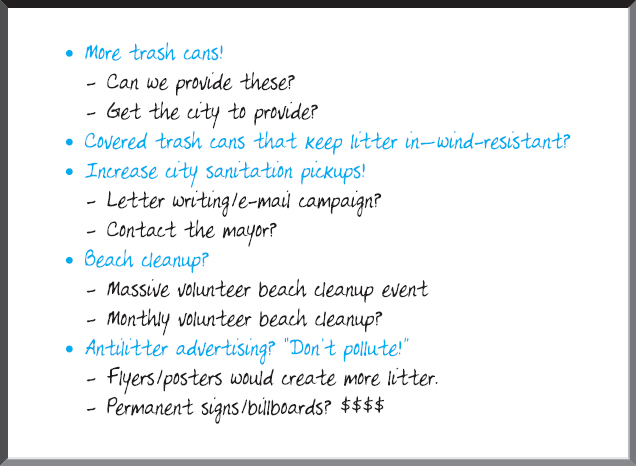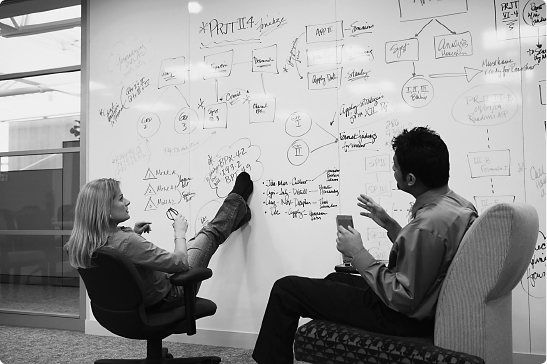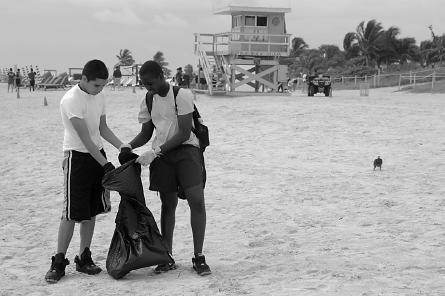The Problem-Solving Process
The Problem-Solving Process
Page 220
To make decisions, groups and their leaders often go through a six-step process (Dewey, 1933). To illustrate these steps, consider EcoCrew, a group of sixteen environmentally active students at a West Coast community college who wish to resolve environmental problems in their community.
Identifying the Problem. The EcoCrew group has scheduled its first meeting in the student union lounge. Susan, the group’s founder, is the designated leader. Deciding to adopt a participative leadership style, Susan invites each person to give his or her perception of the problem the group will set out to address before debates or questions occur. Members pipe up with a number of issues and activities they’d like the group to address. One suggests the elimination of plastic bags from campus shops; another wants to address littering on the beaches.
By inviting members to voice their concerns one at a time, Susan is providing an opportunity for the group to identify and define several problems. Once all the members have presented their views, Susan encourages the group to discuss the various proposed definitions of the problem and agree on one that EcoCrew can productively address. The group decides that litter, both on campus and on the nearby beach, is the most immediately troubling environmental issue.
Having defined the problem it wants to address, EcoCrew has gotten off to an effective start. According to researchers, many groups don’t spend enough time identifying the problem they want to tackle (Gouran, 2003). Without a clear, agreed-on problem, a group can’t work through the rest of the decision-making process in a focused way.
Analyzing the Problem. Having decided to tackle litter cleanup as its primary mission, EcoCrew begins to analyze the problem. Susan suggests that each member carry a diary for a week and note how much litter they see and where. When the group meets again the following week, all members agree that the two biggest litter problems in the area are on the beaches and in the wooded areas surrounding the campus parking lots. Several members note that the trash cans on the beaches are not being emptied often enough by city sanitation workers, causing trash overflow to be blown onto the beach by the ocean wind.
Generating Solutions. Once the EcoCrew team has identified and analyzed the problem, the next step is to come up with a solution. Susan starts asking for ideas from the group and writes them down on a whiteboard, to be evaluated later.
This technique, called brainstorming, encourages members of a group to come up with as many ideas as possible without judging the merits of those ideas yet. The intent is to prompt fresh thinking and to generate a larger number of potential solutions than a group might arrive at if members evaluated each idea as it came up. As the EcoCrew members throw out idea after idea, the whiteboard grows dense and colorful with possibilities (see Figure 10.1).

Technology and You
If you were involved with Susan’s EcoCrew, would you suggest using technology to assist with problem solving? Why or why not? If so, what technologies would you consider?
Once the members have run out of new ideas, they’ll need to narrow down the list. To help them focus on the one or two strongest ideas, Susan invites them to define the criteria that eventual solutions will have to meet. First, Susan reminds them that the primary goal would be to reduce litter on the beach. Another member, Wade, then points out that at this point, the group has no budget, so it needs to limit its initial efforts to tasks that have little or no cost. Another member, Larissa, notes that because the group has a relatively small membership, it should focus on things that either the group can manage on its own or the group could encourage nonmembers to participate in as well. The group concludes that an acceptable solution must meet these key criteria.

Evaluating and Choosing Solutions. Once EcoCrew has generated its list of possible solutions, group members have to evaluate the pros and cons of each idea to consider how well it meets the criteria the members have defined. For example, one member, Kathryn, points out that the lack of funding makes replacing the garbage cans out of the question and would make an antilitter advertising campaign difficult, if not impossible. Wade notes that organizing a beach cleanup would cost next to nothing; they could all volunteer to get together to pick up garbage and clean up the beach. Larissa adds that if they get the word out, they’d also be able to attract additional volunteers—and potential new members—from outside the group to participate. Thus the group decides to launch a monthly beach cleanup: a regular social event to raise awareness of the group, encourage nonmembers to participate and new members to join, and involve little to nothing in terms of cost.
Implementing the Solution. Implementing a solution means putting into action the decision that the group has made. For EcoCrew, this means making plans for the regular beach cleanup. The group focuses first on logistics—setting dates and times. One member, Allison, volunteers to act as a liaison with the county sanitation department to see if it can provide trash bags and picks for the volunteers and to arrange for the sanitation trucks to pick up the trash once it’s been bagged.
Larissa adds that with a bit of legwork, the group could turn the cleanup into a large community event; she volunteers to arrange for an end-of-day gathering and to see if she can get her mother’s sandwich shop to donate food. Wade notes that he can probably get his roommate’s band to entertain free of charge as well.
Assessing the Results. Once a group has implemented its agreed-on solution, members should evaluate the results. Evaluation can shed light on how effective the solution was and whether the group needs to make further decisions about the problem at hand. For EcoCrew, it will be helpful to assess the first event in terms of how well it met the three key criteria:
- Was the beach cleaner at the end of the day as a result of the group’s efforts? Before-and-after photos of the beach reveal a very successful cleanup.
- Did the event wind up costing the members any money? Thanks to the donations of local restaurants and supplies provided by the county sanitation department, the event cost the group absolutely nothing.
- Did the event attract volunteers from outside the group? Fifteen nonmembers participated in the cleanup, among them several schoolchildren who attended with their parents.

By revisiting these criteria, the group is able to tweak its plan for the following month’s cleanup event. Larissa suggests that the members pitch in a few dollars to place an ad in the local paper thanking the volunteers and donors and announcing the date of the next cleanup. Wade follows up by suggesting that the group make a pitch at the local elementary school to get more kids and their families involved. Kathryn volunteers to submit a brief story about the cleanup, along with photos of the event and the results, to the campus newspaper. And Susan suggests holding a raffle at the next event, with half the proceeds paid out in prizes and half retained by the group, to get a small budget started to cover future ads and expenses.
LearningCurve